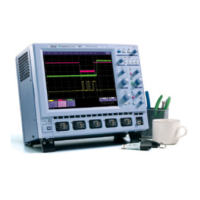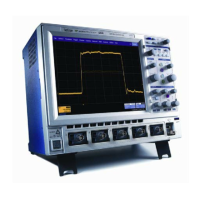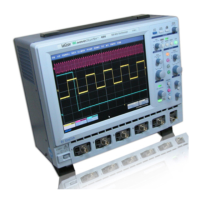Do you have a question about the LeCroy WaveJet 300A series and is the answer not in the manual?
Brief guide to safety, installation, and operating procedures for the oscilloscope.
Explains symbols and terms used for safety on the instrument and in the manual.
Details recommended operating conditions and environmental limits for safe use.
Specifies ventilation needs and precautions to ensure proper cooling.
Covers power requirements, grounding, and safe connection practices.
Instructions for checking received items against the packing list.
Information on product warranty, coverage, and optional maintenance agreements.
Details bandwidth, sensitivity, resolution, and input coupling.
Timebase, clock accuracy, sampling rates, and record length.
Overview of trigger modes, types, sources, and advanced options.
Display types, persistence, zoom, connectivity, and measurement tools.
Power, dimensions, environment, certifications, and conformity.
Instructions on how to turn the oscilloscope on and off.
How to view system status, serial number, and software version.
Steps for downloading and installing firmware updates via USB.
Steps to compensate passive probes for accurate measurements.
Identifies and groups front panel buttons and knobs by function.
Explains controls for trigger setup and timebase adjustment.
Details vertical gain/offset and zoom magnification controls.
Explains controls for intensity, replay, cursors, and measure functions.
Describes buttons like HELP, AUTO SETUP, UTILITIES, DISPLAY, SAVE/RECALL.
Explains indicators like trigger delay and level within the display grid.
Describes information shown in the top and bottom status bars.
Details prompts, system info, and channel/math trace labels.
How to turn channel traces on/off and access their setup menus.
Steps to select input coupling modes (AC, DC, GND) for channels.
How bandwidth limiting reduces noise and prevents aliasing.
Lists available probe attenuation ratios.
How to invert a waveform and adjust volts/division (gain).
How to adjust the vertical offset of a waveform.
How to access and select different sampling modes (Normal, Peak Detect, Average).
How to change the timebase setting using the horizontal controls.
How to select trigger types like Edge, Pulse Width, Period, Pulse Count, TV.
Step-by-step guide to configure an edge trigger with source, slope, and coupling.
Configuration for pulse width trigger criteria and range limits.
Configuration for period trigger criteria and time values.
Configuration for setting the number of pulses to count for triggering.
Setup for triggering on TV signals (NTSC, PAL, Custom).
Adjusting trigger position and voltage level.
Using cursors for accurate signal measurements and analysis.
Explains Time, Amplitude, and Value cursor modes for measurements.
How to position cursors using the ADJUST knob and select tracking.
Details on vertical measurements like Max, Min, Peak-Peak, RMS, Mean, Top, Base.
Details on horizontal measurements like Rise Time, Fall Time, Period, Frequency, Pulse Width.
Explains Integral, Skew, and how to view parameter statistics (Min/Max).
Configuring display settings like type (YT, XY), graticule, and persistence.
How to zoom in on waveforms and adjust magnification factor.
Using replay mode to scroll backwards through past acquisitions.
Procedures for saving and recalling instrument setups to memory.
How to save and recall reference waveforms to internal or USB memory.
How to select math operators (+, -, x, FFT) and FFT window types.
How to capture and save screen images to USB or a printer.
Adjusting language, date/time, beep, panel lock, grid intensity, and trigger counter.
Setting up auto-calibration and performing manual self-calibration.
Viewing system status and loading firmware updates from USB.
Brief guide to safety, installation, and operating procedures for the oscilloscope.
Explains symbols and terms used for safety on the instrument and in the manual.
Details recommended operating conditions and environmental limits for safe use.
Specifies ventilation needs and precautions to ensure proper cooling.
Covers power requirements, grounding, and safe connection practices.
Instructions for checking received items against the packing list.
Information on product warranty, coverage, and optional maintenance agreements.
Details bandwidth, sensitivity, resolution, and input coupling.
Timebase, clock accuracy, sampling rates, and record length.
Overview of trigger modes, types, sources, and advanced options.
Display types, persistence, zoom, connectivity, and measurement tools.
Power, dimensions, environment, certifications, and conformity.
Instructions on how to turn the oscilloscope on and off.
How to view system status, serial number, and software version.
Steps for downloading and installing firmware updates via USB.
Steps to compensate passive probes for accurate measurements.
Identifies and groups front panel buttons and knobs by function.
Explains controls for trigger setup and timebase adjustment.
Details vertical gain/offset and zoom magnification controls.
Explains controls for intensity, replay, cursors, and measure functions.
Describes buttons like HELP, AUTO SETUP, UTILITIES, DISPLAY, SAVE/RECALL.
Explains indicators like trigger delay and level within the display grid.
Describes information shown in the top and bottom status bars.
Details prompts, system info, and channel/math trace labels.
How to turn channel traces on/off and access their setup menus.
Steps to select input coupling modes (AC, DC, GND) for channels.
How bandwidth limiting reduces noise and prevents aliasing.
Lists available probe attenuation ratios.
How to invert a waveform and adjust volts/division (gain).
How to adjust the vertical offset of a waveform.
How to access and select different sampling modes (Normal, Peak Detect, Average).
How to change the timebase setting using the horizontal controls.
How to select trigger types like Edge, Pulse Width, Period, Pulse Count, TV.
Step-by-step guide to configure an edge trigger with source, slope, and coupling.
Configuration for pulse width trigger criteria and range limits.
Configuration for period trigger criteria and time values.
Configuration for setting the number of pulses to count for triggering.
Setup for triggering on TV signals (NTSC, PAL, Custom).
Adjusting trigger position and voltage level.
Using cursors for accurate signal measurements and analysis.
Explains Time, Amplitude, and Value cursor modes for measurements.
How to position cursors using the ADJUST knob and select tracking.
Details on vertical measurements like Max, Min, Peak-Peak, RMS, Mean, Top, Base.
Details on horizontal measurements like Rise Time, Fall Time, Period, Frequency, Pulse Width.
Explains Integral, Skew, and how to view parameter statistics (Min/Max).
Configuring display settings like type (YT, XY), graticule, and persistence.
How to zoom in on waveforms and adjust magnification factor.
Using replay mode to scroll backwards through past acquisitions.
Procedures for saving and recalling instrument setups to memory.
How to save and recall reference waveforms to internal or USB memory.
How to select math operators (+, -, x, FFT) and FFT window types.
How to capture and save screen images to USB or a printer.
Adjusting language, date/time, beep, panel lock, grid intensity, and trigger counter.
Setting up auto-calibration and performing manual self-calibration.
Viewing system status and loading firmware updates from USB.
| Channels | 2 or 4 |
|---|---|
| Vertical Resolution | 8 bits |
| Input Coupling | AC, DC, GND |
| Maximum Input Voltage | 400 V (DC + peak AC) |
| Power Supply | 100-240 VAC, 50/60 Hz |
| Bandwidth | 100 MHz, 200 MHz |
| Input Impedance | 1 MΩ |
| Trigger Types | Edge, Pulse |
| Interface | USB |
| Sample Rate | 2 GS/s (1 channel), 1 GS/s (2 channels) |
| Display | 8.4-inch color TFT LCD |


